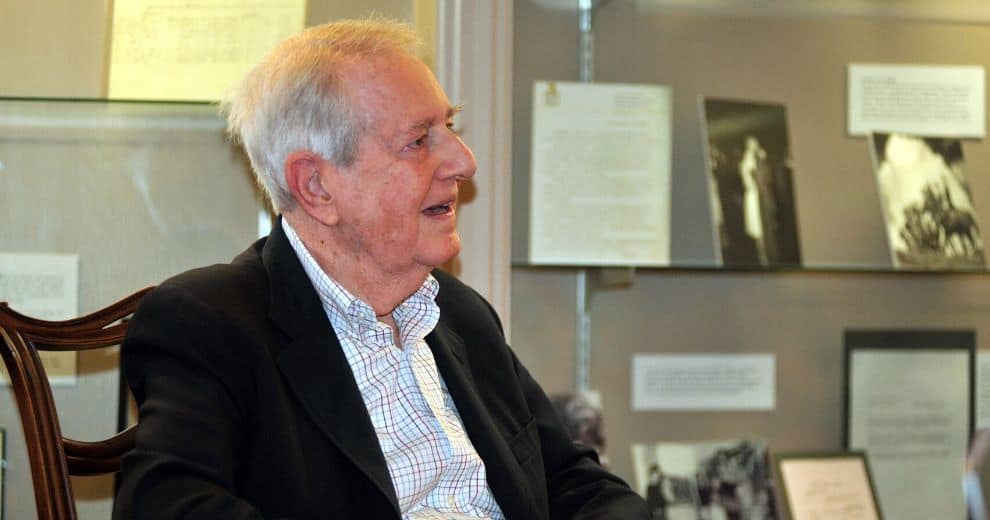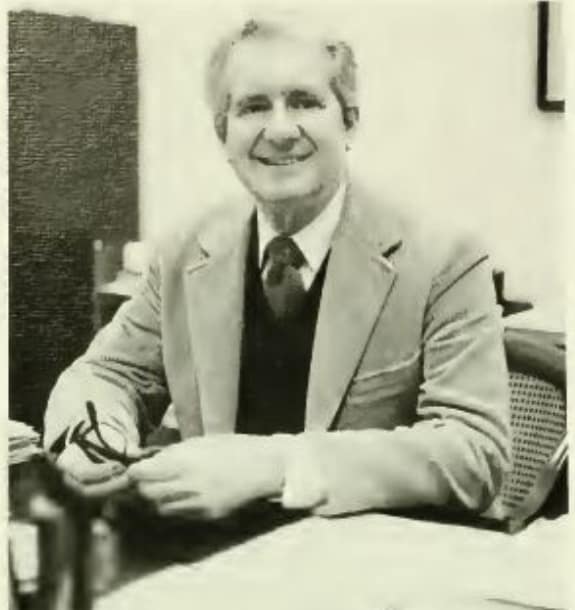Depending on when they spent their time at Mary Baldwin, members of the university community will remember Bill Pollard as the librarian, the volunteer archivist, or the institutional historian. In any era, Pollard was always regarded as an enthusiastic and immensely helpful gentleman and researcher. He died on March 27 at 97 years old.
“His service, particularly as archivist, was exceptional,” said MBU President Pamela Fox. “A gentle, wise, and humble soul, he preserved our history. I was blessed to have known him.”
Pollard was library director at Mary Baldwin until his retirement in 1992, and he served as chair of the university’s sesquicentennial celebration. He then took on a volunteer position for 20 years as the school’s first and only archivist. For this he was named an honorary alumnus of the university.
To further honor Pollard’s work and dedication, Fox announced this week that the Mary Baldwin University archives would be named in his memory during a special dedication on Founders Day this fall.

Pollard had a strong track record of learning about key pieces of the institution’s history and, in many cases, tracking down artifacts, including the large stained-glass window commemorating Mary Julia Baldwin’s achievements now prominently displayed in the Grafton Library.
He found the window in a coal bin in the basement of old Bailey Hall, which was demolished in 2001 to make way for the Program for the Exceptionally Gifted Center.
When Pollard became MBU’s archivist, he told MBU news that “literally, things were in attics and closets around campus.” Among his other discoveries are a painting of Baldwin’s dog Beauty, used as a prop in a theatrical production, and a Mary Baldwin apple crate, left over from the days when the school owned an orchard that inspired Apple Day. He spotted the crate at a nearby apple farm. “I knew what it was,” he said. “I had seen the photograph.”
In his most recent role, Pollard fielded all manner of questions from faculty, staff, and alumni, including genealogical work on behalf of the grandchildren and great-grandchildren of students long ago. He previously shared an office with Patricia H. Menk, the late professor emerita of history and author of To Live in Time: The Sesquicentennial History of Mary Baldwin College. Pollard assisted in the writing of that history as well.
Originally from Farmville, North Carolina, Pollard earned an undergraduate degree in comparative literature from the University of North Carolina at Chapel Hill and a master’s degree in library science from Florida State University. Before becoming head librarian at Mary Baldwin in 1977, he held similar positions at the College of William and Mary and at what was then its Norfolk branch, now Old Dominion University. Earlier in his career, he was acquisitions librarian at the University of Georgia.
He is survived by his wife, Elizabeth Hatch “Betsy” Pollard, with whom he lived just a short walk from campus. He is also survived by their three daughters and their husbands, seven grandchildren, and nine great-grandchildren. His daughter, Elizabeth Pollard Hemeter, is a member of the Mary Baldwin Class of 1973.
“He was thoughtful, a gracious host, and a kind man. He and Betsy were a perfect match,” said Lew Askegaard, retired dean of institutional research. Askegaard, along with his wife, Bev, knew Pollard for 35 years and shared their love of dachshunds. “I often came to him for help running down landmarks in Baldwin’s long history. Alumni and faculty would raise arcane questions about great-great-aunts or the impact of the panic of 1893 on enrollment. I loved to go to Bill with these. He was always interested, an eager explorer. He was equally at home when the issue was the history of an old house off the road in Dooms or a little spring … Bill was generous, curious, and a quiet gift to this great college and community.”
Professor of Philosophy Roderic Owen recalls wandering by Pollard’s office on the second floor of Grafton, and always finding a helpful colleague who personified grace and gentility.
“He was always gracious and generous in talking about Mary Baldwin, the resources of Grafton Library, and our shared College of William and Mary connection,” Owen said. “Indeed, I know that Bill was instrumental in helping Dr. Pat Menk research and write the up-to-date version of MBU’s history, and she gave him the full credit that he deserved.”

“He knew everything about Mary Baldwin,” said Carol Creager, university librarian, about Bill Pollard (pictured at left in 1979 when he served as director of Grafton Library).
University Librarian Carol Creager, like so many at MBU, had trouble calling Pollard anything but “Mr. Pollard.” She remembers their last conversation in December and how he began by asking her about her children.
“[He] was formal, but warm in a soft, southern, gentlemanly way. He always asked about my family before getting to the business at hand,” Creager said. “He was generous with his time and knowledge about Mary Baldwin, not only for major milestones in her history, but with everyday questions he fielded.”
Creager said that when Pollard, somewhat quietly, announced his retirement from his volunteer archivist position just a few years ago, she and her colleagues in Grafton panicked.
“He knew everything about Mary Baldwin,” Creager said. “But he left the archives — his archives — wonderfully organized and usable, with written trails of where and how to best find answers. His distinctive handwriting — I think of it as Pollard-dating — leaves clues about when an item was added or reviewed.”
His early type-written letters and notes, sometimes on 3×5 cards, Creager said, are scattered throughout the files and archival boxes and have become historic treasures in themselves.
As Pollard would attest, though, Creager said there’s still work to be done, and several elusive items still to be discovered.
“He searched but never found the administrative papers referenced in the first Mary Baldwin history by Joseph Waddell. Even future historians Watters and Menk could only point to that first history as proof of some of the early seminary developments. And not surprisingly, he was sure there was a photo of Mary Julia out there, somewhere. [There is no known photo of Baldwin. Her face was disfigured during a childhood illness, and she would not permit portraits or photos to be taken.] We’ll keep looking and will work to sustain what he began. The first step will be naming the archives in his honor. We, as well as many others who worked with him over the years, will miss his friendship and his ability to track down that hidden piece of Mary Baldwin history.”